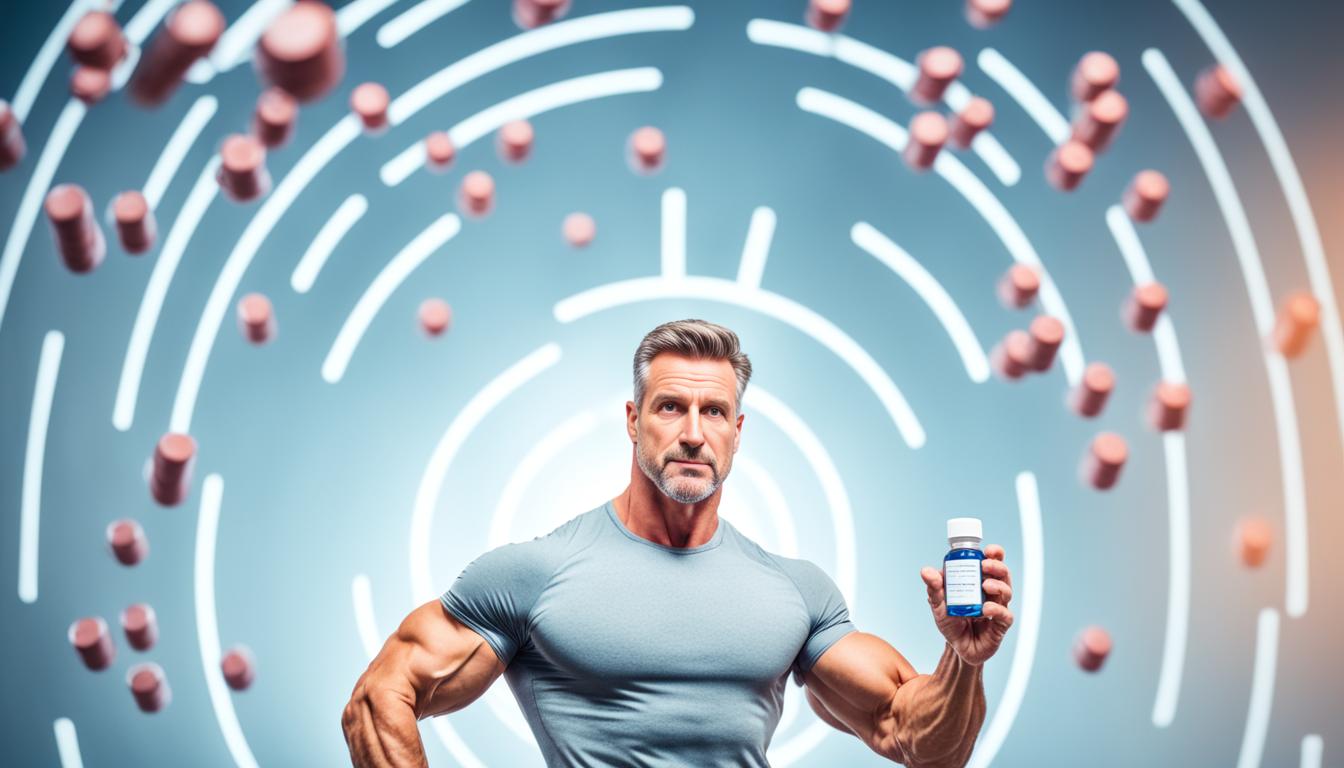Testosterone is essential in men for sexual functions and male features. Low testosterone can cause many issues. These include less interest in sex, trouble getting or keeping an erection, feeling tired, sad, and losing muscle.
There are primary and secondary reasons behind low T. The first involves the testicles not working right. The second is when the pituitary or hypothalamus doesn’t signal the body to produce enough. Testing through blood work and exams is critical for proper treatment planning.
Recently, stem cell therapy has shown promise in treating low testosterone. It aims to boost testosterone production and help with symptoms.
Key Takeaways:
- Low testosterone, or hypogonadism, can lead to various symptoms and complaints.
- Common symptoms of low testosterone include reduced libido, erectile dysfunction, fatigue, depression, and reduced muscle mass.
- Low T can have primary causes, such as testicular failure, or secondary causes, such as dysfunction in the pituitary or hypothalamus.
- Physical examination, blood tests, and other diagnostic measures are necessary for diagnosing low testosterone.
- Stem cell therapy is an emerging treatment option for low testosterone, showing potential in stimulating testosterone production and improving symptoms.
Signs and Symptoms of Low Testosterone
The signs of low testosterone vary by age. In babies, a lack of testosterone can mean not growing male parts well, having female-like parts, or parts that aren’t clear. Teens with low testosterone may not build strong muscles, might have different voices, slow hair growth, and smaller private parts.
As adults, they might lose interest in sex, feel tired, sad, or have trouble in bed. Other signs include not having as much muscle, less hair on the body and face, weaker bones, or problems with their mind and mood. It’s key to spot these signs and get checked by a doctor to see if low testosterone is the reason.
To sum up, low testosterone shows up as:
- Problems with male parts in babies
- Parts that look like a girl’s or are not clear in babies
- Not enough strong muscles in teens
- Changes in voice in teens
- Slow hair growth in teens
- Smaller privates in teens
- Less interest in sex as adults
- Feeling tired all the time as adults
- Feeling sad as adults
- Trouble with sex as adults
- Not as much muscle as adults
- Less body and face hair as adults
- Weak bones as adults
- Mind and mood issues as adults
It’s very important to know these signs for early treatment of testosterone problems. If you see these signs or think you might have low testosterone, talk to a doctor. They can help you figure things out and suggest the right treatment.
Causes of Low Testosterone
Low testosterone, or hypogonadism, has primary and secondary causes. Primary hypogonadism means the testicles are not working properly, causing low testosterone. Secondary hypogonadism is due to problems in the pituitary gland or hypothalamus, impacting testosterone creation.
Primary Causes
Several things can cause primary hypogonadism. This includes:
- Klinefelter syndrome, a genetic disorder where men have an extra X chromosome. This leads to issues with the testicles.
- Testicles that don’t drop into the scrotum properly, a condition known as cryptorchidism.
- Infections like mumps or bacterial infections in the testicles.
- Injuries to the testicles from accidents or sports, impacting their function.
- Therapies like radiation and chemotherapy for treating cancer.
- Metabolic diseases such as hemochromatosis that affect the testicles.
Secondary Causes
Secondary hypogonadism can be from different conditions affecting the pituitary gland or hypothalamus. This includes:
- Kallman syndrome, a genetic disorder affecting the hypothalamus and lessening GnRH production.
- Diseases or tumors in the pituitary gland, decreasing LH and FSH levels, needed for testosterone production.
- Inflammatory diseases that interfere with the hypothalamus or pituitary gland.
- HIV/AIDS, which can damage these glands, causing secondary hypogonadism.
- Using anabolic steroids or opioids, which lower testosterone levels.
- Other conditions like diabetes, obesity, and genetic diseases can also contribute.
- Smoking and excessive alcohol use that interfere with hormone production.
- Liver and kidney diseases, impacting hormone metabolism and testosterone levels.
Identifying the Underlying Cause
Figuring out the cause of low testosterone is key to treating it. Doctors will do a thorough check-up, which includes blood tests and other exams. This helps to pinpoint the reason behind the low hormone levels. Once the cause is known, the right treatment can be planned, making it possible to manage low testosterone better.
Advances in Stem Cell Therapy for Low Testosterone Treatment
Stem cell therapy is changing how we treat low testosterone and hypogonadism. It brings new hope by using stem cells. These stem cells boost testosterone production by becoming Leydig cells.
This method aims to replace and better Leydig cell function. Consequently, it could normalize testosterone and improve health. Studies worldwide are looking into how well this therapy works and if it’s safe. So far, the early signs are good, with patients seeing big leap in their symptoms.
For those with low testosterone looking for a new treatment, stem cell therapy is an option. It’s a different path than just taking testosterone shots. Also, Thailand is a leading place for innovative medicine, offering fresh solutions for hormone problems. In Thailand, stem cell therapy for low testosterone is an area of active research. It gives hope to people who want a personalized approach to treat their low testosterone.

